福州大学:《翻译》课程教学资源(PPT课件讲稿)汉译英教案(共七章)
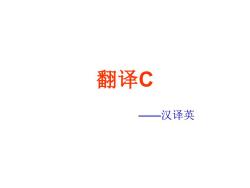
翻译C 一汉译英
翻译C ——汉译英
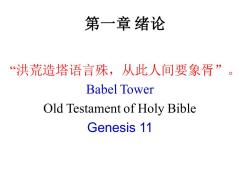
第一章绪论 洪荒造塔语言殊,从此人间要象胥”。 Babel Tower Old Testament of Holy Bible Genesis 11
第一章 绪论 “洪荒造塔语言殊,从此人间要象胥”。 Babel Tower Old Testament of Holy Bible Genesis 11
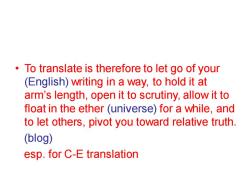
To translate is therefore to let go of your (English)writing in a way,to hold it at arm's length,open it to scrutiny,allow it to float in the ether(universe)for a while,and to let others,pivot you toward relative truth. (blog) esp.for C-E translation
• To translate is therefore to let go of your (English) writing in a way, to hold it at arm’s length, open it to scrutiny, allow it to float in the ether (universe) for a while, and to let others, pivot you toward relative truth. (blog) esp. for C-E translation
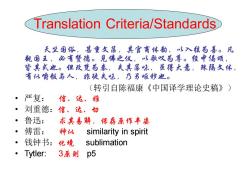
Translation Criteria/Standards 天丝国俗,甚重文藻,其宫商体韵,以入弦为善。凡 觐国王,必有赞德。见佛之仪,以歌叹为尊。经中偈项, 皆其式也。但改梵为秦,失其藻味,虽得大意,殊隔文体, 有似嚼饭与人,非徒失味,乃另呕秽也。 (转引自陈福康《中国译学理论史稿》) 严复: 信、达、雅 ·刘重德:信、达、切 ·鲁迅: 求其易解,保存原作丰姿 ·傅雷:神似 similarity in spirit 钱钟书:化境sublimation Tytler: 3原则p5
Translation Criteria/Standards 天竺国俗,甚重文藻,其宫商体韵,以入弦为善。凡 觐国王,必有赞德。见佛之仪,以歌叹为尊。经中偈颂, 皆其式也。但改梵为秦,失其藻味,虽得大意,殊隔文体, 有似嚼饭与人,非徒失味,乃另呕秽也。 (转引自陈福康《中国译学理论史稿》) • 严复: 信、达、雅 • 刘重德:信、达、切 • 鲁迅: 求其易解,保存原作丰姿 • 傅雷: 神似 similarity in spirit • 钱钟书:化境 sublimation • Tytler: 3原则 p5
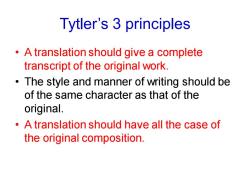
Tytler's 3 principles A translation should give a complete transcript of the original work. The style and manner of writing should be of the same character as that of the original. A translation should have all the case of the original composition
Tytler’s 3 principles • A translation should give a complete transcript of the original work. • The style and manner of writing should be of the same character as that of the original. • A translation should have all the case of the original composition
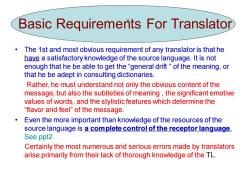
Basic Requiremenits For Translator The 1st and most obvious requirement of any translator is that he have a satisfactory knowledge of the source language.It is not enough that he be able to get the"general drift"of the meaning,or that he be adept in consulting dictionaries. Rather,he must understand not only the obvious content of the message,but also the subtleties of meaning,the significant emotive values of words,and the stylistic features which determine the "flavor and feel"of the message. Even the more important than knowledge of the resources of the source language is a complete control of the receptor language. See ppt2 Certainly the most numerous and serious errors made by translators arise primarily from their lack of thorough knowledge of the TL
Basic Requirements For Translator • The 1st and most obvious requirement of any translator is that he have a satisfactory knowledge of the source language. It is not enough that he be able to get the “general drift “ of the meaning, or that he be adept in consulting dictionaries. Rather, he must understand not only the obvious content of the message, but also the subtleties of meaning , the significant emotive values of words, and the stylistic features which determine the “flavor and feel” of the message. • Even the more important than knowledge of the resources of the source language is a complete control of the receptor language. See ppt2 Certainly the most numerous and serious errors made by translators arise primarily from their lack of thorough knowledge of the TL

It is one thing,however,to know a language in general and another to have a special knowledge of a particular subject. In other words,in addition to a knowledge of the two or more languages involved in the translation process, the translator must have a thorough acquaintance with the subject matter concerned. The translator should also have something of the same cultural background as that of the author he is translating.If such is not the case,"the translator should be willing and readily able to make up for this deficiency. At the same time,a translator must be content to be like his author,for it is not his business to try to excel him
• It is one thing, however, to know a language in general and another to have a special knowledge of a particular subject. In other words, in addition to a knowledge of the two or more languages involved in the translation process, the translator must have a thorough acquaintance with the subject matter concerned. • The translator should also have something of the same cultural background as that of the author he is translating. If such is not the case, “the translator should be willing and readily able to make up for this deficiency.” At the same time, a translator must be content to be like his author, for it is not his business to try to excel him
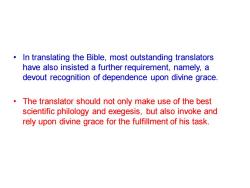
In translating the Bible,most outstanding translators have also insisted a further requirement,namely,a devout recognition of dependence upon divine grace. The translator should not only make use of the best scientific philology and exegesis,but also invoke and rely upon divine grace for the fulfillment of his task
• In translating the Bible, most outstanding translators have also insisted a further requirement, namely, a devout recognition of dependence upon divine grace. • The translator should not only make use of the best scientific philology and exegesis, but also invoke and rely upon divine grace for the fulfillment of his task
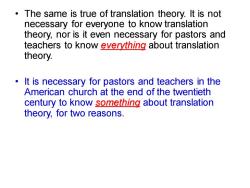
The same is true of translation theory.It is not necessary for everyone to know translation theory,nor is it even necessary for pastors and teachers to know everything about translation theory. It is necessary for pastors and teachers in the American church at the end of the twentieth century to know something about translation theory,for two reasons
• The same is true of translation theory. It is not necessary for everyone to know translation theory, nor is it even necessary for pastors and teachers to know everything about translation theory. • It is necessary for pastors and teachers in the American church at the end of the twentieth century to know something about translation theory, for two reasons
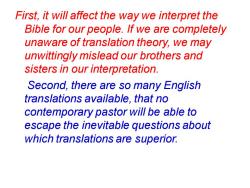
First,it will affect the way we interpret the Bible for our people.If we are completely unaware of translation theory,we may unwittingly mislead our brothers and sisters in our interpretation. Second,there are so many English translations available,that no contemporary pastor will be able to escape the inevitable questions about which translations are superior
First, it will affect the way we interpret the Bible for our people. If we are completely unaware of translation theory, we may unwittingly mislead our brothers and sisters in our interpretation. Second, there are so many English translations available, that no contemporary pastor will be able to escape the inevitable questions about which translations are superior
按次数下载不扣除下载券;
注册用户24小时内重复下载只扣除一次;
顺序:VIP每日次数-->可用次数-->下载券;
- 《翻译》课程教学资源(试卷习题)高级口译试卷参考答案.pdf
- 《翻译》课程教学资源(试卷习题)汉译英试卷参考答案.pdf
- 《翻译》课程教学资源(试卷习题)实用汉译英期末考试试卷(参考答案).pdf
- 《翻译》课程教学资源(试卷习题)英语专业八级考试翻译部分历届试题(1995-2005).pdf
- 福州大学:《翻译》课程教学资源(PPT课件讲稿)实用汉译英——第六单元 公共标牌的翻译 Translation of Signboards.ppt
- 福州大学:《翻译》课程教学资源(PPT课件讲稿)实用汉译英——第七单元 名片翻译 Translation of Business Cards.ppt
- 福州大学:《翻译》课程教学资源(PPT课件讲稿)实用汉译英——第四单元 论文摘要与标题 Translation of Thesis Titles and Abstracts.ppt
- 福州大学:《翻译》课程教学资源(PPT课件讲稿)实用汉译英——第五单元 饮食文化翻译 Translation of Catering Culture.ppt
- 福州大学:《翻译》课程教学资源(PPT课件讲稿)实用汉译英——第三单元 企业宣传资料翻译 Translation of Corporate Promotional Material/Literature.ppt
- 福州大学:《翻译》课程教学资源(PPT课件讲稿)实用汉译英——第二单元 实用翻译策略与常用技巧 Unit 2 Strategies and Techniques.ppt
- 福州大学:《翻译》课程教学资源(PPT课件讲稿)实用汉译英——第一单元 总论(授课人:陈小慰).ppt
- 《翻译》课程教学资源(PPT课件讲稿)中级口译 05 中级口译词汇 Glossary Preview.ppt
- 《翻译》课程教学资源(PPT课件讲稿)中级口译 04 Theory and Skills In Interpreting.ppt
- 《翻译》课程教学资源(PPT课件讲稿)中级口译 03 口译的理论与技巧.ppt
- 《翻译》课程教学资源(PPT课件讲稿)中级口译 02 An Introduction - Professional Interpreting.ppt
- 《翻译》课程教学资源(PPT课件讲稿)中级口译 01 Teaching Schedule.ppt
- 《翻译》课程教学资源(PPT课件讲稿)英译汉——06 成语concise.ppt
- 《翻译》课程教学资源(PPT课件讲稿)英译汉——04 Commonly Used Methods in Translation 4.6 视点转换 Shifts of perspectives.ppt
- 《翻译》课程教学资源(PPT课件讲稿)英译汉——04 Commonly Used Methods in Translation 4.5 省略 Omission.ppt
- 《翻译》课程教学资源(PPT课件讲稿)英译汉——04 Commonly Used Methods in Translation 4.4 重复 Repetition.ppt
- 福州大学:《翻译》课程教学资源(PPT课件讲稿)科技翻译——Chapter 1 概论及要求(主讲:王雅慧).ppt
- 福州大学:《翻译》课程教学资源(PPT课件讲稿)科技翻译——Chapter 2 标准及文体 Stylistics variation.ppt
- 福州大学:《翻译》课程教学资源(PPT课件讲稿)科技翻译——Chapter 3 词汇翻译 Word Translation.ppt
- 福州大学:《翻译》课程教学资源(PPT课件讲稿)科技翻译——Chapter 4 句子翻译1.ppt
- 福州大学:《翻译》课程教学资源(PPT课件讲稿)科技翻译——Chapter 5 句子翻译2.ppt
- 福州大学:《翻译》课程教学资源(PPT课件讲稿)科技翻译——Chapter 6 篇章的翻译 Translation Strategies-Passage.ppt
- 福州大学:《翻译》课程教学资源(PPT课件讲稿)省情翻译——I.Overview Translating Fujian(授课人:陈小慰).ppt
- 福州大学:《翻译》课程教学资源(PPT课件讲稿)省情翻译——II.Principles and Methods of Translating about Fujian.ppt
- 福州大学:《翻译》课程教学资源(PPT课件讲稿)省情翻译——III.Basic information about Fujian.ppt
- 福州大学:《翻译》课程教学资源(PPT课件讲稿)省情翻译——IV. Fujian in Fast Development.ppt
- 福州大学:《翻译》课程教学资源(PPT课件讲稿)省情翻译——V. Economy and Trade Fairs.ppt
- 福州大学:《翻译》课程教学资源(PPT课件讲稿)省情翻译——VI. Local customs in Fujian.ppt
- 福州大学:《翻译》课程教学资源(PPT课件讲稿)省情翻译——VII. Local Dishes in Fujian.ppt
- 福州大学:《翻译》课程教学资源(PPT课件讲稿)省情翻译——VIII. Touring Fujian.ppt
- 珠海科技学院:《英语精读》课程教学大纲(英语精读一).doc
- 珠海科技学院:《英语精读》课程教学大纲(英语精读二).doc
- 珠海科技学院:《英语精读》课程教学大纲(英语精读三).doc
- 珠海科技学院:《英语精读》课程教学大纲(英语精读四).doc
- 珠海科技学院:《英语精读》课程授课教案(英语精读一).doc
- 珠海科技学院:《英语精读》课程授课教案(英语精读二).doc
